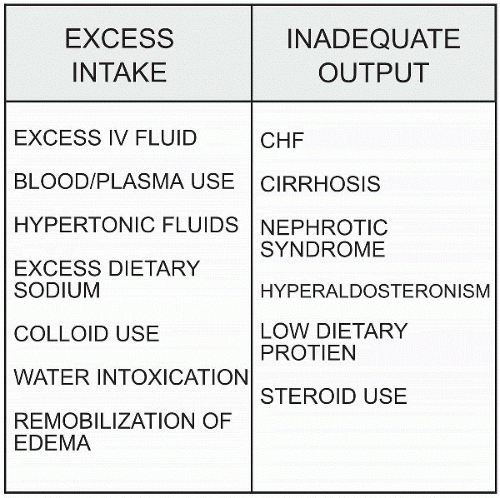Fluid Overload
QUICK LOOK AT THE CHAPTER AHEAD
Fluid overload can occur in either the extracellular or intracellular compartments of the body. Extracellular fluid overload occurs in either the intravascular compartment or in the interstitial area. Intracellular fluid overload occurs inside the cell and is known as water intoxication. When sodium and water remain in equal proportions with each other, a situation known as isotonic fluid volume excess occurs. Excess sodium and fluid are the primary causes of extracellular overload. In this chapter we highlight the causes, manifestations, and treatment for extracellular and intracellular fluid overload.
Edema is the common term associated with fluid overload found in the interstitial or lung tissue. When an overabundance of fluid occurs in the intravascular compartment, the condition is known as hypervolemia. The cause for overhydration may be associated with excess sodium.
Situations exist, however, when sodium and water remain in equal proportions with each other. This type of fluid overload, known as isotonic fluid volume excess, results from a decreased elimination of sodium and water. Normally, the body compensates and attempts to restore the fluid balance through the homeostatic mechanisms associated with antidiuretic hormone, atrial natriuretic peptide, or aldosterone. If these mechanisms malfunction due to diseases or failing organs, hypervolemia develops. The extra volume of fluid puts an excessive strain on the left
side of the heart, which over time causes the heart to fail, allowing blood to back up into the pulmonary system and causing pulmonary edema. In other areas of the body dependent edema appears first in the sacrum and lower extremities and then becomes generalized throughout the body, a condition known as anasarca (Table 9-1).
side of the heart, which over time causes the heart to fail, allowing blood to back up into the pulmonary system and causing pulmonary edema. In other areas of the body dependent edema appears first in the sacrum and lower extremities and then becomes generalized throughout the body, a condition known as anasarca (Table 9-1).
 Isotonic fluid volume excess is a type of fluid overload that results from a decreased elimination of sodium and water. Sodium and water remain in equal proportions with each other.
Isotonic fluid volume excess is a type of fluid overload that results from a decreased elimination of sodium and water. Sodium and water remain in equal proportions with each other.Causes of Extracellular Fluid Overload
Fluid overload may result from excessive sodium intake through diet or administration of hypertonic fluids. Inadequate sodium or water elimination resulting in fluid overload may occur with conditions of hyperaldosteronism, Cushing’s syndrome, and renal, liver, or congestive heart failure (Table 9-2). A water deficit resulting from excessive diarrhea or diaphoresis, diabetes insipidus (decreased antidiuretic hormone), may also result in a fluid imbalance.
Stay updated, free articles. Join our Telegram channel

Full access? Get Clinical Tree



